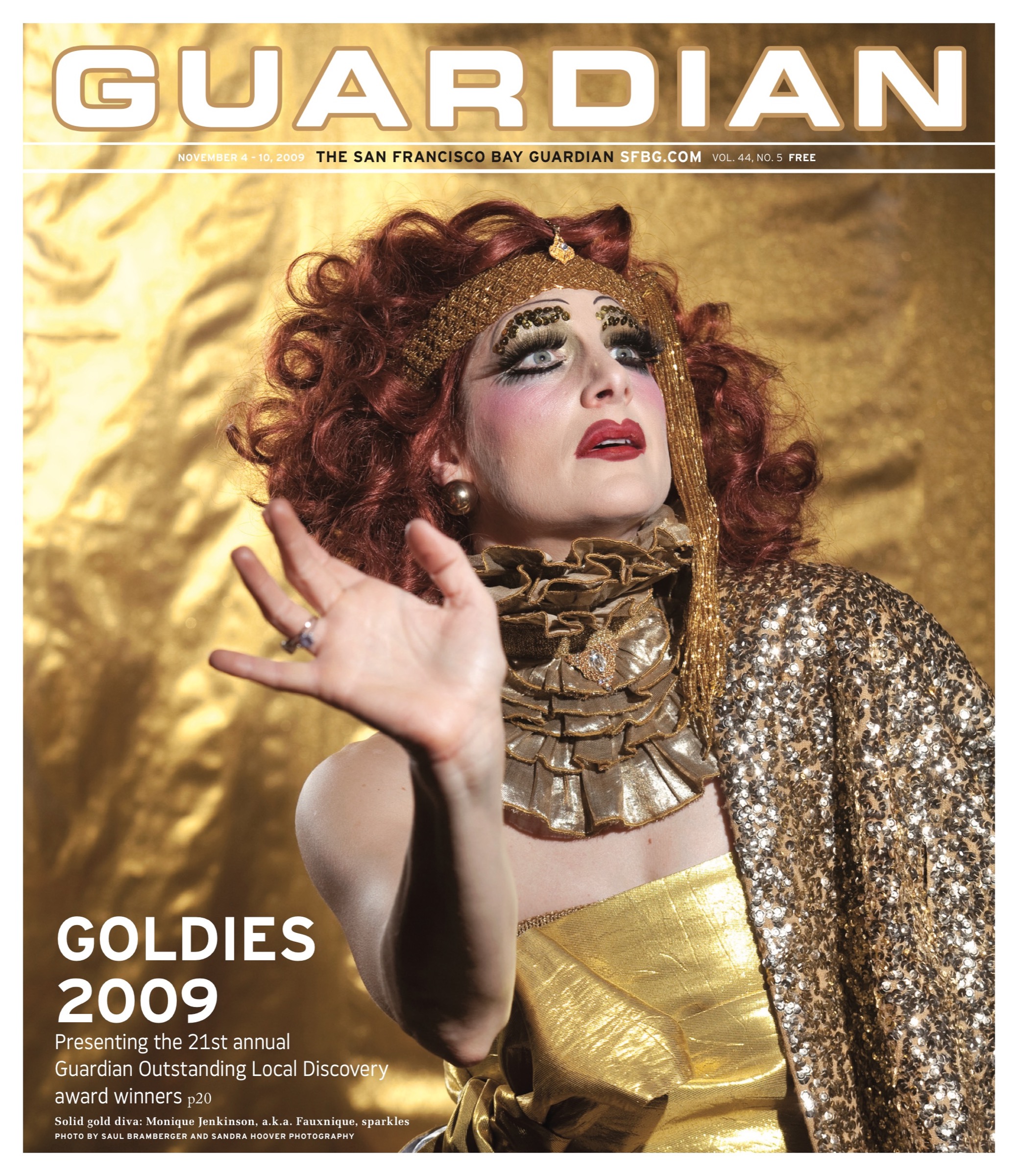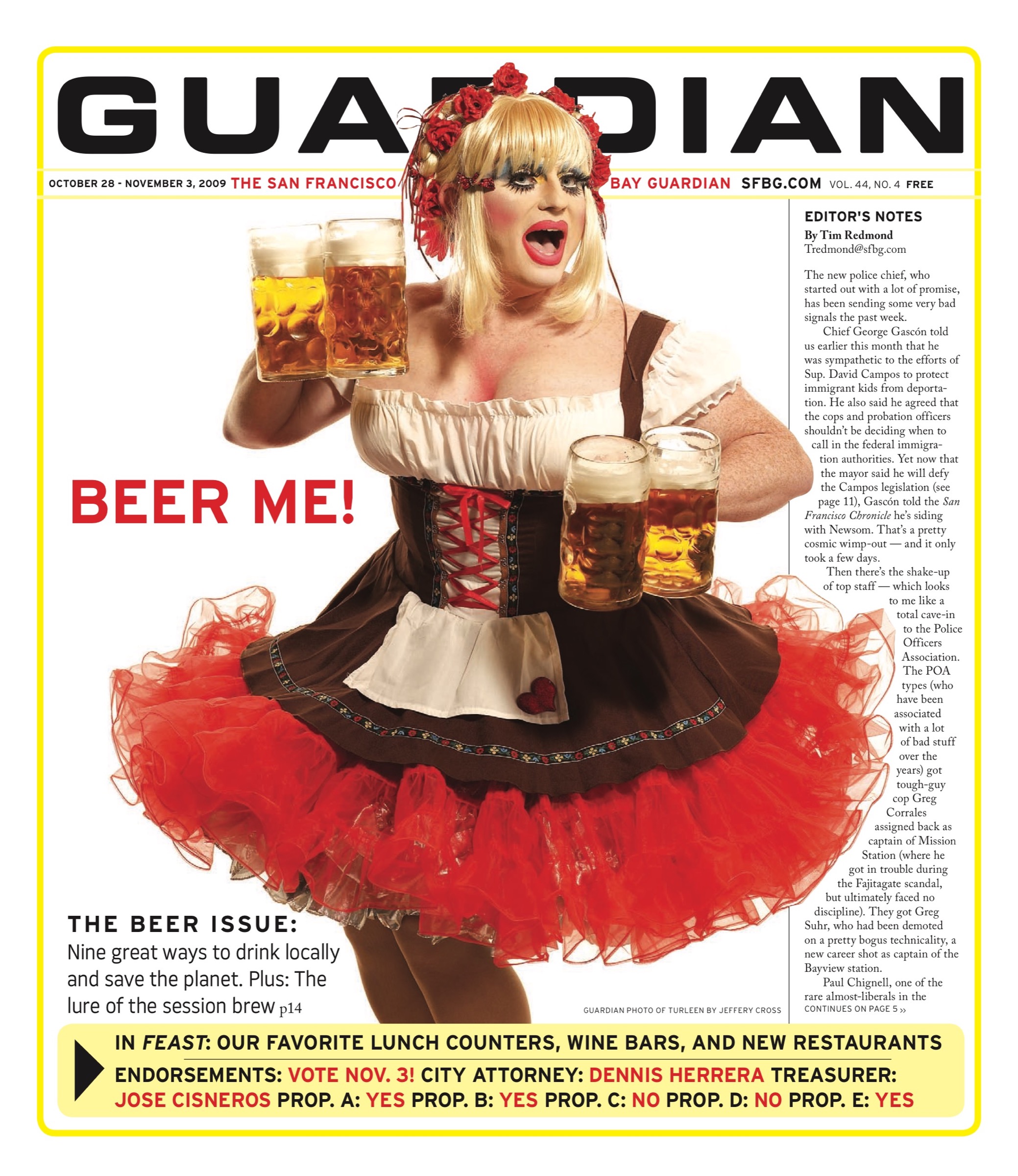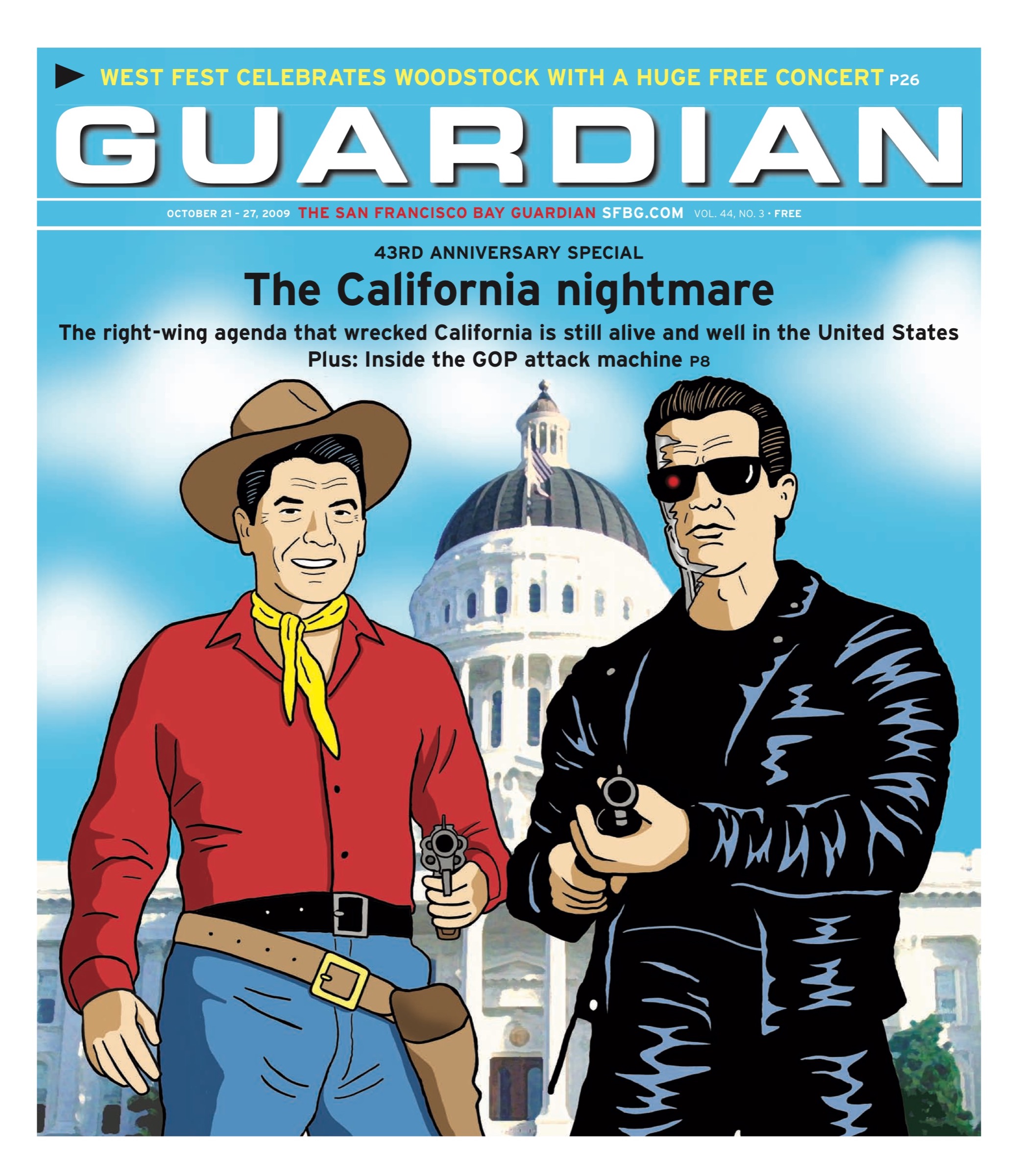› a&eletters@sfbg.com
**Update: The Paid Dues Independent Hip Hop Festival has been cancelled. See below for more details.
I’m not accustomed to receiving rappers at my home at 8 a.m. — an hour most rappers have only heard of — but I made an exception for Tajai Massey, member of Souls of Mischief and Hieroglyphics. A self-confessed early riser and the first MC to ever accept my offer of a cup of coffee, Massey is a busy man.
While gearing up for the Hieroglyphics’ Freshly Dipped tour, which kicks off June 14 with the Paid Dues Festival at the Berkeley Community Theatre, the lanky 33-year-old head of the group’s Hiero Imperium label was about to head to Seattle for a spot date with his new rock outfit, Crudo, with Dan the Automator and ex-Faith No More frontman Mike Patton. Meanwhile Massey’s been juggling two upcoming projects, one of which he hopes to release in the fall: a new, self-produced Hieroglyphics disc and the fourth studio release by Souls of Mischief, produced by legend Prince Paul. In the interim, he’s prepping fellow Souls-member Opio’s second solo album, Vulture’s Wisdom, Vol. 1 (Hiero Imperium), for July.
Yet none of this accounts for our meeting. Our conversation instead focused on Massey’s other job: overseeing his own imprint within Hiero, Clear Label. Though begun in 1999 to release his SupremeEx trip-hop collaboration with Hiero Web designer StinkE, Projecto: 2501, Clear Label really established itself circa 2005 with two artists of a very different sort: Shake Da Mayor of "Stunna Shades" fame and Beeda Weeda, whose 2006 full-length, Turfology 101, yielded the hit "Turf’s Up."
While Shake has since departed, Beeda has cemented his Clear Label connection, moving his whole camp, Pushin’ the Beat (PTB), into Hiero’s two-story East Oakland compound, which was purchased by the veteran collective in 2004. Known within Hiero as "the Building," though designated "Hiero" by everyone else, the space houses nine rooms, five studios, and a small warehouse of T-shirts, CDs, and other goods. Soon Beeda’s friend and collaborator, J-Stalin — himself signed to one of the Bay’s biggest rap independent labels, SMC — began bringing his own Livewire crew by, including Shady Nate, Clear Label’s next signee.
Bulging with the usual conglomeration of computers, mixing boards, rough-hewn vocal booths, and a fine layer of empty 1800 bottles and Swisher Sweet ashes, PTB’s two ground floor studios contrast with the Building’s general tidiness, like a kids’ playspace in an otherwise adult house. Yet they also exhibit an atmosphere of dedication. Dropping by on any given day, among the crowd of just-past-high-school aspiring MCs, you might see Beeda and Stalin studiously hunched over spiral notebooks with Mistah FAB, working on their NEW (North-East-West) Oakland project.
And FAB isn’t the only high profile visitor: everyone from San Quinn to the Federation comes through. Too $hort stops by regularly, and even national acts like Dem Franchize Boyz and Cease of Junior Mafia have found their way here. Given that Beeda and Stalin are two of the hottest young Oakland rappers and attract such elite company, Hiero suddenly finds itself at the center of what might be called the Bay’s post-hyphy moment, one embodied in a tougher, less dance-oriented sound, combined with classic Bay slap and tempered by R&B overtones.
"I wasn’t after a bunch of streeter-than-street dudes," Massey said, laughing. "But I sure ended up with some."
THE OTHER BAY BRIDGE
Intentional or not, the current emphasis on street rappers is consistent with Clear Label’s overall mission.
"Our fans aren’t that forgiving. Even bringing up other acts like Knobody or Musab, who are on the same tip as Hiero — our fans want Hiero music," Massey said, in reference to Hiero Imperium artists and the group’s demanding backpacker following. "So we’ll give it to them, and let Clear Label be the outlet for other acts, especially my relationship with PTB/Livewire."

Oakland hip-hop converges on the Hiero HQ. Photos by Alexander Warnow
It helps, Massey continued, that J-Moe, the CEO of PTB, has a vision. "That dude is a genius," the Clear Label honcho said. "He’s called the Machine, because he’s always working." With an uncanny ability to spot new talent — like 17-year-old phenom Yung Moses, who J-Moe dubs "the future face of the franchise" — the Machine is a crucial part of the evolution of Clear Label.
But Clear isn’t just a "street label," Massey continued. He’s working with a "rock ‘n’ roll" dude, Chris Maarsol, as well as League 510, which he describes as working in "really a new genre." Hailing from East Oakland, 510 blends lyrical, positive rap and house-influenced grooves in a mix the group calls "Town Techno." "It’s like bridging the hyphy movement and the alternative crowd," Massey said. "I know they’ll do well in cities like Miami, Chicago — where they have a house scene — and in Europe."
Interestingly, according to Massey, European fans have been more receptive to Hiero’s new connections than the domestic audience. "It’s crazy," he said with a laugh. Among other acts, Massey also scooped up Baby Jaymes, digitally re-releasing his 2005 debut, The Baby Jaymes Record (Ghetto Retro), and dropping a new single, "The Bizness," including Turf Talk. "Baby Jaymes is huge in Germany and Belgium, even Australia," Massey added. "I’m in Amsterdam and people are like, ‘Where’s Beeda Weeda?’ Out there people understand the association, whereas in Oakland, they have no idea. It’s odd how Europeans look deeper into it, and it’s a whole different language."
‘WE ALL FROM OAKLAND’
Perhaps it isn’t so odd. The language barrier may even facilitate European acceptance, because despite the differences between Hiero’s conscious lyricism and PTB/Livewire’s grimy topics, the musical bond is already there.
"There are more similarities than differences," Opio told me. "We all from Oakland. Hiero looked to Too $hort and E-40 when we began our independent hustle."
Though he admittedly can’t keep track of the crews’ ever-expanding rosters, former Hiero Imperium head Domino — who, after helming the organization from its mid-’90s inception, stepped down in 2006 to concentrate on production — also welcomes the influx of young talent. "As you get older," he said, "there’s not the same excitement as an artist. You can’t totally get it back, but you can feed off their new energy."
Beyond their shared approval, members of Hiero have already begun to collaborate with PTB/Livewire. Souls member A-Plus, for example, produced the dancehall-inspired opener, "Da Town," on Beeda’s new all-original mixtape, Talk Shit Swallow Spit — possibly the hottest Bay Area disc this year — while Casual appears on Beeda’s forthcoming album, tentatively titled Turf Radio. PTB, moreover, has added a more conscious lyricist, Tre Styles, upsetting what Opio describes as "the boxes the corporate market puts people in."
Massey agrees. "Look at Beeda or Shady. Their mentality isn’t ‘go dumb, go stupid,’<0x2009>" he noted. "Their lyrics are militant, and these guys are growing." Massey was also quick to point out the multidimensional side of J-Stalin, whose crime-ridden raps are infused with melancholy ambivalence about street life. "Stalin could be big like 2Pac," he opined. "He’s not trying to look hard. He’s a little dude, but he’s got all this heart and emotion."
Stalin himself is more modest, albeit slightly, at least concerning his upcoming SMC disc, The Pre-Nuptial Agreement. "Pre-Nup is going to be one of the greatest Bay Area albums ever," he said. "I ain’t saying I’m the best rapper. I’m saying I put together a great album." Judging by the songs he played for me that day — including the radio-ready "Get Me Off" with E-40 — he’s right. SMC’s Will Bronson is sufficiently confident in Stalin — and Beeda — to partner with Thizz Entertainment this summer to bring out the former’s Gas Nation as well as the latter’s The Thizzness, both pre-albums designed to tide fans over before their full-lengths in the fall.
"Stalin and Beeda are the only two new artists really buzzin’," Bronson said. "I couldn’t go a week without hearing about them."
As a result, Stalin and SMC plan to collaborate on future Livewire projects, including a group disc showcasing up-and-comers Shady and J Jonah, longtime members such as ROB, Lil Blood, and Ronald Mack, and newer recruits like Philthy Rich and 17-year-old Lil Ruger, whose wild, almost Keak-esque flow foretells fame.
The connection to SMC and Vallejo’s Thizz, moreover, suggests a serious new coalition which, given the waning of hyphy, threatens to become the next major force in Bay Area rap. "We’re just trying to keep the unity," Stalin concluded. "Because we’re all from different places, we wouldn’t be able to do this in the street."
UNITED FRONT
Such unity, always in short supply in the Bay, is one of the most intriguing aspects of the Hiero/PTB/Livewire situation. "We’ve got a movement, but it’s not a movement," said Jamon Dru, who, along with DJ Fresh, Tower, and others, formed the Whole Shabang, an autonomous production squad linked to both PTB and Livewire. "We’re trying to make music everyone will feel, not just the Bay. That’s put a hurt on us because we do have a ‘fuck everyone else’ attitude, like, ‘I don’t care if anyone else likes this shit.’ But we got families, friends, people in jail we gotta feed. We can’t be half-steppin’ like that."
Like Traxamillion, and unlike many local producers, Dru is candid about the influence of the radio on his sound. "It’s a little Southern-influenced," he said, "a little East Coast with Fresh chopping up samples, but with the 808s and a West Coast bassline. Every beat we make with samples, we gotta put an 808 knock in it." While it’s difficult to generalize, given the work of so many producers, Dru’s statement is a good sketch of the PTB/Livewire sound: it looks to the Bay’s older mob music through the modern lens of hyphy, even as it sheds the more gimmicky excesses of the latter.
Beginning his career under Beeda Weeda’s wing, Dru is already a mogul of his own, currently developing 19-year-old Gully, whose work can sampled on his mixtape Hustla Movement. Like Yung Moses, the saltier-voiced, vowel-stretching Gully is considered one of the most promising rappers in the camp, and the two are already slated for a collaboration. A song like Gully’s "Bush," imagining the life of a ghetto youth who suddenly finds himself a soldier in Iraq, even suggests that Hiero’s more politically progressive themes are creeping into the youngster’s work.
At present, however, Beeda remains the "face of the franchise" for PTB and Clear Label.
"Beeda’s got the biggest buzz," Massey said, "so it makes sense to lead off with him. I just want to set him up properly." Proper set-up in the Bay generally involves a "pre-album," and Beeda’s got three. Besides the all-original Talk Shit mixtape and The Thizzness, Beeda’s collaboration with DJ Fresh, Base Rock Baby — an ’80s-themed disc referring to Beeda’s generation as the first to be born after the crack epidemic began — appears in July.
"We’re going to push that online," Massey said, though there will be hard copies for sale. "Right now, if Beeda’s record sales matched his popularity, I’d be ready to retire." Still, he confessed, "everyone has Turfology, but only a few people bought it," citing the difficulties of selling albums in the era of burnt CDs and file-sharing, not to mention ongoing recession under the George W. Bush administration.
Another problem was the lag between Beeda’s video for "Turf’s Up" becoming popular on YouTube and the actual release of Turfology, confusing consumers who assumed the CD was already out. "This time we got the timing down," Beeda said. "We’ll build that buzz first, and everything will be ready to go." Nonetheless, as falling numbers of mainstream releases attest, selling albums has grown increasingly difficult regardless of timing.
"That’s not how we eat anymore," Dru said. "You put out an album to get shows and verse features [guest appearances on other artists’ songs]. So we gotta look at these songs as bait." Massey, meanwhile, is seeking other income streams to support his label and artists, like soundtracks and licensing.
As Massey confirms, street rap comes with headaches not usually associated with Hiero. A few weeks ago, as Clear Label began preparing Shady Nate’s debut, Son of the Hood, for release, Shady was arrested on an alleged weapons violation and remains incarcerated pending trial.
"They’re trying to throw the book at him," Massey said. "I’m hoping we can work it out because Shady’s a good dude, and his album is great." Even if Shady has to do a stretch in prison, Son of the Hood will probably see the light of day sometime later this year.
Ultimately the big question for PTB/Livewire is whether the coalition can achieve the mainstream success that eluded the hyphy movement. Beeda and Stalin think so, and with the support and mentorship of the Hiero camp, they have as good a chance as any in the Bay — and maybe even the best.
With the long view of a rapper 15 years into his career, Massey is philosophical about the prospects of his Clear Label empire. "If we break even it’s cool," he said. "If we make money, even better. But if I break even, I’m happy, because it wasn’t a loss for me to put out great music."
PAID DUES FESTIVAL***
With Hieroglyphics and others
Sat/14, 5 p.m., $40
Berkeley Community Theatre
1900 Allston, Berk.
www.ticketmaster.com
***This show has been cancelled. From the promoters: Guerilla Union and MURS 3:16 regret to announce that the PAID DUES INDEPENDENT HIP HOP FESTIVAL scheduled for Saturday, June 14 at the Berkeley Community Theatre in Berkeley, CA, has been cancelled due to matters beyond our control.
For fans that have purchased tickets to the show, we apologize for any inconvenience this may have caused. Refunds are available for ticketholders at the point-of-purchase.




